#panzer spearheads
Explore tagged Tumblr posts
Text

A motorcycle team from the 21st Panzer Division spearheads the German Army’s spring Offensive - Gulf of Bomba, 1942
#world war two#ww2#worldwar2photos#history#1940s#ww2 history#wwii#world war 2#ww2history#wwii era#libya#Tobruk#gulf of Bomba#motorcycle#motorcycle riders#sidecar#1942
182 notes
·
View notes
Text
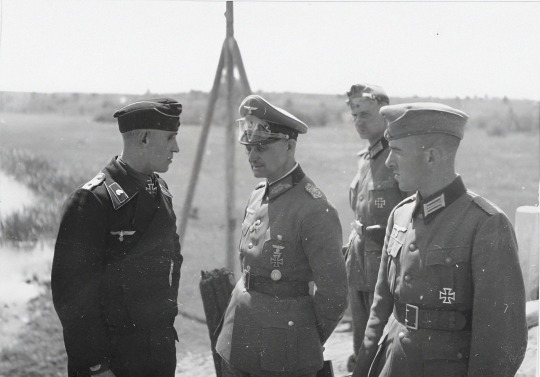
The division commander, Lieutenant General Model, speaks with the head of the Panzer spearhead company, Knight's Cross recipient First Lieutenant Buchterkirch, about the further attack, July 1941
Photo: War correspondent Fritz Lucke, reporting company of the Ob.d.H.
#ww2#wwii#ww2 germany#panzer#second world war#world war 2#world war two#ww2 history#1942#1940s#germany#world war ii#war history#history#militar
130 notes
·
View notes
Text




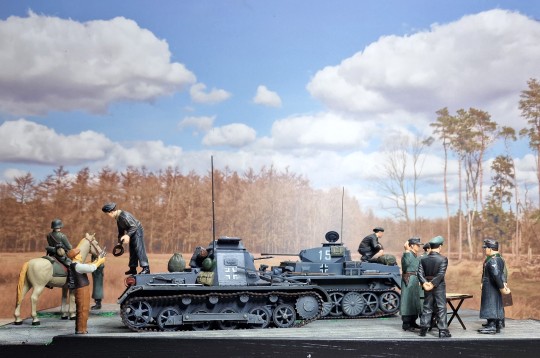
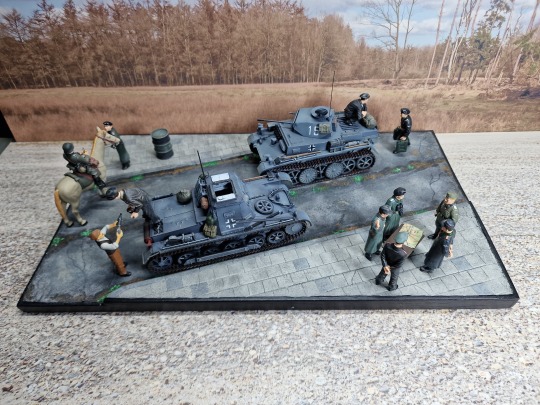
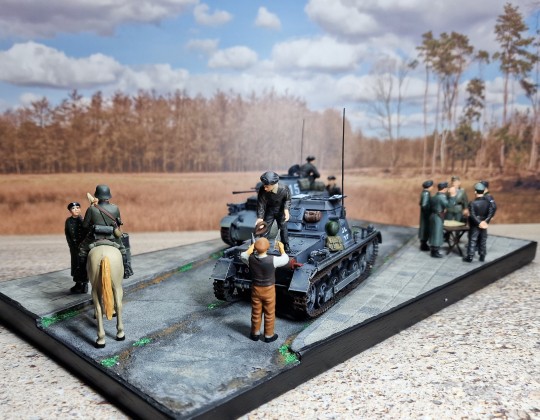
Diorama nr.52 The Panzer spearhead tête-à-tête.
Just imagin France 1940 panzers figuring out were to go next.
33 notes
·
View notes
Text

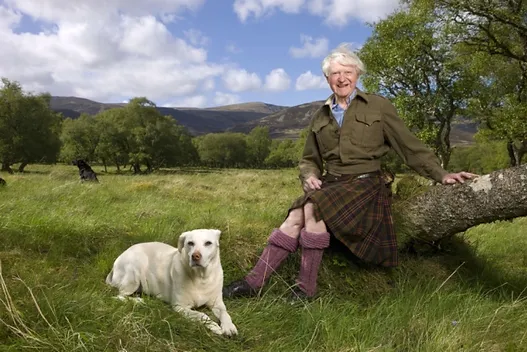
On 6th November 2014 Colonel Sir Ronald Thomas Stewart Macpherson known to his friends as Tommy, and his enemies as the "Kilted Killer"passed away.
Tommy was born October 4th 1920 in Edinburgh, the was youngest of seven children of Sir Thomas Stewart Macpherson and Helen Cameron, he was educated at Edinburgh Academy prep school before Cargilfield, in Barnton. At 14, he went to Fettes College, where he joined the Officers' Training Corps. He also attended Trinity College, Oxford, where he was awarded a first class degree in Philosophy, Politics and Economics.Tommy represented Oxford at rugby, hockey and athletics and was also an international student athlete at 1500 metres. His older brother, Phil was captain of Scotland's first Grand Slam winning rugby side in 1925.
At the outbreak of WWII Macpherson was commissioned in the Queen’s Own Cameron Highlanders before joining the commandos a year later, he was captured by Italian troops during a reconnaissance on the headquarters of Field Marshal Rommel in North Africa, after two failed escape attempts they sent him to, another camp at Gavi, near Genoa, then onto several Stalags, during which of course he tried again to escape!!! He was almost shot this time it was a countermand from the German Officer that saved him. By 1943 he was in Stalag XVIII-A in Austria and on September 21st after several attempts he managed to make good his escape.
Macpherson and 3 others managed to travel to Sweden via Bromberg and Gdynia before flying back to Kinloss, Scotland on 4th November 1943, two years after he had been captured in Egypt.
BUT!! Yes men like Mcpherson rarely lay on their laurel, he was seconded to a special operation named “Jedburgh”. Under this operation three man units were to be dropped into occupied Europe to carry out sabotage and guerrilla warfare, acting as a high-profile focus for the local resistance.
Two days after the Allies had stormed the Normandy beaches, he was parachuted behind enemy lines in France wearing his Highlander’s battledress aye, including his kilt. The unit was tasked with liaising with French resistance and causing mayhem and boy was he successful, the Germans soon had wanted posters plastered all across France with a 300,000 franc bounty placed describing and he was described as "A bandit masquerading as a Scottish officer and extremely dangerous to the citizens of France". His appearance caused quite a stir among the local Resistance fighters, many who had never seen a man in a kilt before. One excited young man even mistook him for a French officer’s wife!
On one occasion when a German staff car was approaching a level crossing Macpherson booby-trapped the barrier arm so it crashed down on the vehicle, decapitating the local commandant and his driver.
Macpherson’s finest hour came that summer in 1944, around 23,000 hardened German troops were travelling to Normandy so it was imperative that they were stopped, or at least, delayed. A small band of the French resistance held a vital bridge in the Loire valley, preventing them from passing. But with 23,000 soldiers, there was only going to be one victor if it came to a battle. Armed with this information, Macpherson stole a German jeep and drove through ten miles of enemy soldiers, until he reached their field headquarters.
Stepping out of the vehicle, the star of so many wanted posters demanded an audience with the commanding officer, Major General Elster. Elster was stunned. The king of bluff, Macpherson cooly informed Elster that he had 20,000 of his own men nearby, along with tanks and RAF bombers waiting in the wings. Surrender, laddie, or die he threatened, Tommy was only 21 at the time!
Of course, this was all complete and utter guff but Elster fell for it, hook, line and sinker. 23,000 enemy soldiers, spearheaded by the feared SS Panzer Division, had waved the white flag to MacPherson.
With France freed from Nazi rule, Tommy was quickly dispatched to Italy to do it all again. It was here that he faced a new enemy, Yugoslavian leader Tito, who was intent on taking parts of Italy. Given Macpherson’s tried and tested methods of killing sprees, blowing bridges and destroying supplies and communications, a second bounty was placed on his head.
After the war he continued to serve in the territorials for a number of years, he also loved his rugby and was a regular player at fly-half for London Scottish as skipper of the 2nd XV but playing mostly for the 1st XV.from 1946 to 1955 when he hung up his boots.
There’s a wee bit more about this very brave man here. https://dirkdeklein.net/2016/03/11/forgotten-history-major-tommy-macpherson/
11 notes
·
View notes
Photo
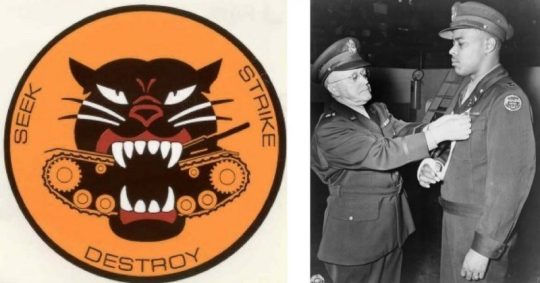
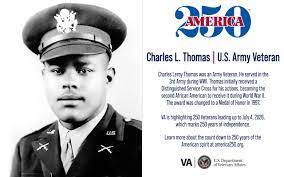
Charles Leroy Thomas was born 17 April 1920 in Birmingham, Alabama. He grew up in Detroit and graduated from Cass Technical High School in 1938. Thomas then worked as a molder for the Ford Motor Company (Ford River Rogue factory) with his father, and was a student at Wayne State University studying mechanical engineering.
He was drafted, and entered the U.S. Army on January 20, 1942, at Fort Custer, Michigan. He completed Basic and Advanced Infantry Training at Camp Wolters and was assigned to the Infantry Replacement Training Center at Camp Wolters.
When the Army began forming tank destroyer units, Thomas was transferred to Camp Carson, Colorado and joined the segregated 614th Tank Destroyer Battalion, which had been activated on July 25, 1942. The soldiers were African, but most of the officers were white. Thomas quickly rose to the rank of Sergeant during unit training and was chosen to attend the Tank Destroyer Officer Candidate School (OCS) Class # 21 at Camp Hood, Texas when the battalion was transferred to Camp Bowie Texas on December 18, 1942.
Thomas was commissioned a second lieutenant upon graduation from OCS on March 11, 1943, and returned to Camp Bowie to assume command of Company C, 614th Tank Destroyer Battalion and prepared the unit for the move to Camp Hood that was completed on March 23, 1943.
On August 27, 1944, he deployed with the 614th to England, arriving on September 7. On October 8, the 614th was on Utah Beach in Normandy, France. The 614th led by Lieutenant Colonel Frank S. Pritchard, then would join General Patton's Third Army in Metz, France. The 614th saw its first combat on November 28. On December 5, the 614th was attached to 411th Infantry Regiment, and on December 6, the 614th was attached to the 103rd Infantry Division..
On December 14, 1944, 1st Lt. Thomas volunteered to lead 3rd Platoon, C Company, 614th Tank Destroyer Battalion in a task force named "Task Force Blackshear" to storm and capture the village of Climbach, a strategically important town which was five miles from the German border. The task force spearheaded by Thomas' M20 scout car (modified M8), consisted of a platoon of Sherman tanks from the 47th Armored Battalion, 14th Armored Division, a platoon of F Company (riding on tanks), 411th Infantry, 103rd Infantry Division, 3rd Platoon, C Company, 614th Tank Destroyer Battalion, rest of F Company, 411th Infantry, and a heavy weapons platoon. Approaching Climbach was uphill, Thomas' armored scout car was knocked out by enemy fire from the German 21st Panzer Division, and he was wounded.
Thomas helped his crew out of the vehicle, but as he left the car's protection, he was again wounded in the chest, legs and arms. Despite his wounds, Thomas directed the dispersal and emplacement of the anti-tank guns, which then returned fire and covered the attempt by the rest of the task force to outflank the defenders. He briefed the 3rd Platoon leader of C Company, a first lieutenant, on the general situation, and only when he was sure the situation was under control did he allow himself to be evacuated. 3rd Platoon, C Company continued to fight for four hours, losing two of its four guns and over half its men as casualties (3 dead, 17 wounded).
The "valorous conduct" of the platoon, "in the face of overwhelming odds enabled the task force to capture its objective", the village of Climbach, and forced the defenders to withdraw to the Siegfried Line. 3rd Platoon, C Company, 614th Tank Destroyer Battalion, was awarded a Distinguished Unit Citation, the first black combat unit, and the first unit attached to the 103rd Division to be so honored. Its soldiers received four Silver Stars and nine Bronze Stars. Captain Thomas received the Distinguished Service Cross on February 20, 1945, and returned home a hero, though he played down his role – "I know I was sent out to locate and draw the enemy fire, but I didn't mean to draw that much." Thomas remained in the Army, and retired with the rank of major on August 10, 1947.
Thomas married in 1949, and his wife and he had two children. He went to work as a missile technician at Selfridge Air Force Base and later as a computer programmer for the Internal Revenue Service. He died of cancer on February 15, 1980. He was buried in Westlawn Cemetery in Wayne, Michigan.
In the early 1990s, it was determined that African soldiers had been denied consideration for the Medal of Honor (MOH) in World War II because of their race. In 1993, the U.S. Army had contracted Shaw University in Raleigh, North Carolina, to research and determine if there was racial disparity in the review process for recipients of the MOH. The study commissioned by the U.S. Army, described systematic racial discrimination in the criteria for awarding decorations during World War II. After an exhaustive review of files, the study recommended in 1996 that ten African Americans who served in World War II be awarded the MOH. In October of that year, Congress passed legislation that would allow President Clinton to award the Medal of Honor to these former soldiers. Seven of the ten including Thomas were approved, and awarded the MOH (six had Distinguished Service Crosses revoked and upgraded to the MOH) on January 12, 1997. On January 13, 1997, President Clinton presented the MOH to the seven African Americans; Major Thomas and five others were posthumously presented the MOH. A niece of Thomas accepted his MOH during the ceremony. Vernon Baker was the only living recipient of the medal at the time.
Medal of Honor Citation stated the following:
For conspicuous gallantry and intrepidity at the risk of his life above and beyond the call of duty: Then Lieutenant Charles L. Thomas distinguished himself by extraordinary heroism in action on 14 December 1944. One platoon of Company C, 614th Tank Destroyer Battalion, was designated as the lead element in a task force formed to storm and capture the village of Climbach, France. Lieutenant Thomas, the Commanding Officer of Company C, realized, with the obscurity of information regarding the enemy and a complete lack of reconnaissance, the mission would be an extremely dangerous one. Fully cognizant of the danger, Lieutenant Thomas volunteered to command the selected platoon of his company and ride in the column's leading vehicle - a highly maneuverable, but equally vulnerable, M-20 scout car. Lieutenant Thomas knew that if there was a concentration of enemy armor in the village, as was believed, he would absorb the initial shock of the first enemy resistance. The task force left Preuschdorf, France, at 1023 hours, and proceeded to advance in column toward Chimbach. Lieutenant Thomas in his scout car stayed well in front of the column. At 1400 hours, upon reaching the high ground southeast of the village, Lieutenant Thomas experienced initial contact with the enemy. As his scout car advanced to an exposed position on the heights, he received intense direct fire from an enemy artillery, self-propelled guns, and small arms at a range of seven hundred yards. The first burst of hostile fire disabled the scout car and severely wounded Lieutenant Thomas. He immediately signaled the column to halt. Before leaving the wrecked vehicle, Lieutenant Thomas and the crew found themselves subjected to a veritable hail of enemy fire. Lieutenant Thomas received multiple gunshot wounds in his chest, legs, and left arm. In spite of the intense pain caused by his wounds, Lieutenant Thomas ordered and directed the dispersion and emplacement of his first two antitank guns. In a few minutes these guns were effectively returning the enemy fire. Realizing that it would be impossible for him to remain in command of the platoon because of his injuries, Lieutenant Thomas then signaled for the platoon commander to join him. Lieutenant Thomas then thoroughly oriented him as to the enemy gun positions, his ammunition status, and the general situation. Although fully cognizant of the probable drastic consequences of not receiving prompt medical attention, Lieutenant Thomas refused evacuation until he felt certain that his junior officer was in full control of the situation. Only then did Lieutenant Thomas allow his evacuation to the rear. Throughout the action, Lieutenant Thomas displayed magnificent personal courage and a complete disregard for his own safety. His extraordinary heroism spurred the soldiers of the platoon to a fierce determination to triumph, and resulted in a mass display of heroism by them. Lieutenant Thomas' intrepid actions throughout the operation reflect the highest traditions of the military service.
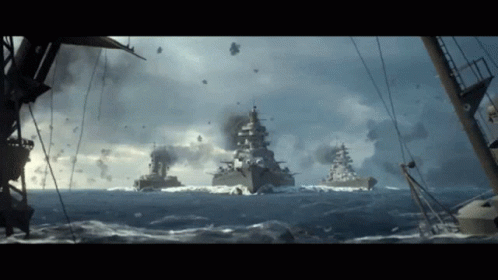
37 notes
·
View notes
Text

8/18/23: r/SketchDaily theme, "Free Draw Friday." This week's character from my anthro WWII storyline is Sigrid Richter. She started as a minor character who appears only briefly in a comic relief role, but considering how the plot goes, she may end up taking on a bigger role. There'll be more about her later in my art Tumblr and Toyhou.se.
Regarding her design, she's a blue dachshund. I'm iffy on her hair design.
TUMBLR EDIT: Sigrid hasn't revealed her background to me yet, largely because I haven't paused to think it over, being busy dealing with other, more important characters. I'll reveal the bigger role she may end up taking, though.
She first appeared in a scenario where undercover American spy Sgt. Stephen Gerhardt and resistance leader Josef Diamant show up at her house, discussing plans, assuming she's out. She abruptly appears and sees them. I believe she's met with Gerhardt already, but you don't really "meet" with Diamant unless he's in disguise, or you're with the Allies. Neither of which applies to Sigrid. Diamant's identity is revealed. "A miscreant?" Sigrid exclaims, as if aghast; then, clasping her hands together: "How DELIGHTFUL!" Turns out she doesn't mind if the Diamond Network makes use of her house; the scandal it could cause, even if only in theory, is so delicious she just can't resist. This was where Sigrid's character was intended to be left, just a minor goofy role of little consequence...yet it seems in this story that even the bit characters can end up playing elaborate roles with a lot of bearing on the plot. (Hello, Unnamed Busboy.)
Sigrid's tentative plot point involves Ultima Thule, the final story arc which occurs a year or so after the war's end, when it's revealed that a handful of surviving Nazis and sympathizers had fled to the Alps and set up base in a hidden fortress from which they've been carrying on Project Doomsday's successor, Project Ultima Thule. Previously they'd been interested in creating a supersoldier. Now they're interested in immortality itself. On the rodent side of the story, the party spearheading this effort is Ludolf Jäger, along with his wife Magda and unwilling assistance from Indigo and Silver Rat. On the canine side of the story, while Gunter Hesse, Konrad Helmstadt, Lars Franke, and the Unnamed Panzer Commander are intended to play major roles...I have no idea who TF is behind it all. Dr.s Mengele and Arzt are involved in perfecting the serum that Dr. Kammler (from the rodent side) created, but by the time of this story, Arzt is dead and Mengele has escaped elsewhere (he's not a major character, in fact, I still waffle over whether his name will actually be given in the story or not). So neither of them can be the story's mastermind. And unless a new character pops up out of nowhere--which is unlikely by this point BUT still possible, look at everyone else who's popped up for this reboot--I currently have no one to really fill this role. :/
Sigrid Richter popped back into my mind when I pondered this situation harder. She's a freaking unlikely mastermind...but maybe that's an asset? Similar to Corporal Julian, could she play a completely unexpected bad guy? Considering the traditional roles women played in Nazi Germany--NOT as leaders or masterminds--it would be intriguing. She's obviously not the brains behind the whole thing, but she might be the only one left behind able to carry on the role. Also considering how harmless, and possibly demented, she seems in the earlier story when she meets Diamant, nobody would expect someone like her to be left in charge of the project.
There IS another party who may step in here. I keep imagining minor interactions Lt.s Hesse and Paul Wozniak have with the woman in charge of a Lebensborn maternity home (the place where Wozniak meets the unmarried mother--she still needs a name--whom he marries and adopts the child of as a cover for his homosexuality). She's a strict, austere sort who's always trying to wheedle Hesse into spreading his good German genes--similar to Himmel in the rodent side of the story, Hesse is unmarried, somewhat older and more experienced than most of his fellows, and is considered prime Aryan family material, but shows no inclination to settle down. (Hesse actually has a mistress, though they both believe she's unable to have children until late in the story.) This unnamed Lebensborn woman pesters Hesse whenever she sees him, trying to convince him to at least help get some nice young ladies pregnant if he doesn't want to marry; though Hesse finds the concept of Lebensborn to be strange and unnerving (Major Jan Delbrück, who participated in this manner for a while, quit for this exact reason--"It got weird"), so he constantly declines. Anyway. I can easily envision a fanatic-type woman like this being involved in Project Ultima Thule, though whether instead of Sigrid, or alongside her, I'm unsure yet. I'm leaning toward them working together.
Anyway again, Sigrid and her exact role in the plot are currently wide open to further development at a time when I have the opportunity to brainstorm. There are a few other names on my old character list who haven't been dropped yet and could provide fodder for the lacking final story arc as well.
[Sigrid Richter 2023 [Friday, August 18, 2023, 2:00:16 AM]]
2 notes
·
View notes
Text
Spearhead & Mnemocide

Sei dabei, wenn der Bolt Thrower Panzer von Spearhead aus Deutschland einfährt und sie der britischen Kult-Death Metal-Band Tribut zollen! Groovige Stampf-Attacken von den Baslern von Mnemocide eröffnen den denkwürdigen Abend in der Met-Bar! Eintritt: 20.00 CHF Doors: 20.00 Uhr Konzertende: ca. 23.30 Uhr Der Vorverkauf läuft bis 19.00 Uhr am Konzerttag. Die restlichen Tickets werden an der Abendkasse verkauft. Reservationen nehmen wir keine entgegen. Zahlung ist nur mit Bargeld möglich. SPEARHEAD Nach dem bitteren Ende von Bolt Thrower sind SPEARHEAD aus Hannover seit 2017 auf den Bühnen unterwegs, um das musikalische Erbe von Bolt Thrower am Leben zu erhalten. Mit höchster Hingabe und Authentizität zollen SPEARHEAD als Bolt Thrower Tribute/Coverband den Death Metal Legenden Bolt Thrower ihren Tribut. Das Set von SPEARHEAD umfasst sowohl "neuere" Songs als natürlich auch altbewährte Klassiker und wahre Death Metal Meisterstücke aus längst vergangenen Tagen. Feiert zusammen mit SPEARHEAD und lasst euch zurückversetzen in die guten alten Zeiten des Death Metal. - MARCHING ONWARDS - MNEMOCIDE Mnemocide wurde 2017 von fünf gestandenen Metallern aus der Region Basel gegründet. Das Quintett begann auf dem Fundament langjähriger Erfahrung und gemeinsamen Bandaktivitäten im dunklen Keller ihrer Vision von brachialem, groovenden Death Metal Gestalt zu verleihen. Die Band durfte sich Live neben Einzelgigs auch bereits an mehreren Festivals wie das BScene Basel, Freak Out Festival (Dust Bolt, Total Annihilation) Headbanger’s Ball (Debauchery, Sear Bliss, Requiem), Meh Suff Winterfestival (Paradise Lost, Dismember, Grave) das geneigte Publikum durch seinen intensiven und energiegeladenen Auftreten in den Bann ziehen. Nach der EP „Debris“ (2018) veröffentlicht das Quintett im Frühling 2020 ihr erstes Album „Feeding The Vultures“ welches wiederum nahe Freiburg (DE) in den Iguana Studios unter der versierten Regie von Produzent Christoph Brandes (u.A. The Spirit, Unlight, Thron, Necrophagist, Finsterforst) eingetrümmert wurde. Die wuchtige und zeitgemässe Produktion lässt die Songs im Besten Licht erstrahlen und die Reaktionen auf das Album sind begeistert! Mit diesem Album im Gepäck und reichlich Motivation wollen Mnemocide nun auf den Bühnen der Welt ihren Siegeszug antreten!! Quelle: Met-Bar Lesen Sie den ganzen Artikel
0 notes
Text
W2 - Mobius
french artist, real name Jean Giraud.
1938 -2012.
A sevearly influencial french artist. His work and themes was heavily influenced by hallucinogenic drugs and philosophy. Assossiated witn new wave comics and often puplished in "heavy Metal" Magazine and the label les Humanoïdes Associés. gathering places for new artists. Heavy metal was a french sci fi fantasy magazine of les Humanoïdes Associés label. It was widely influencial, unconventional and imaginative
He Influenced.... Ridley Scott, George Lucas, Luc Besson, William Gibson, and Hayao Miyazaki?
Influenced Bladerunner, (via the comic incqal a personal fave yumm) Hayao Miyazaki's Nausicaä of the Valley of the Wind was super Mobiues inspired.
Lots of video games were influenced by him. ptrobably becasue genre assossiations and trend cycles. EG Aquamarine, sable, Panzer dragoon
Known for works like: "blueberry' (gritty western with large imact on westrn comcis)
The fantasy series "Arzach"

Mobius himself was inspired by Leonardo Da Vinci, Rembrandt Van Rijn, Winsor McCay, Harold Foster, Jijé, Jack Kirby, Robert Crumb and Jean-Claude Mézières.
Notably.. Robert crumb. Spearhead of underground adult american comics

0 notes
Text
Battle of the Bulge: Then and Now :: Jean-Paul Pallud
Battle of the Bulge: Then and Now :: Jean-Paul Pallud
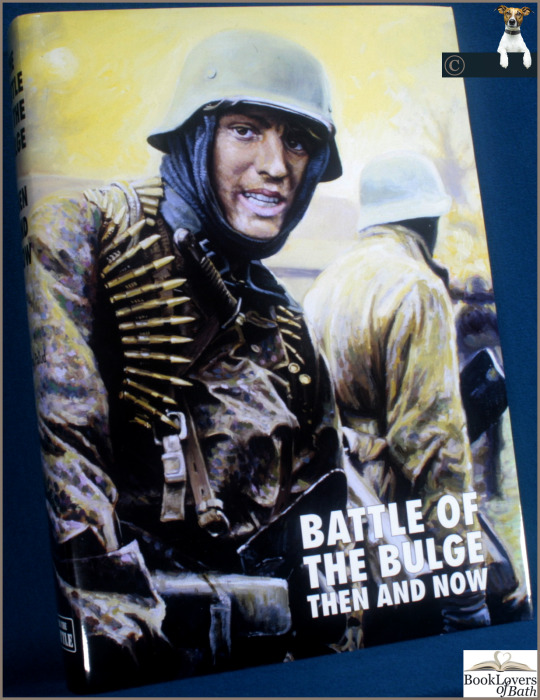
View On WordPress
#1939 1945 war#978-0-9009-1340-2#armeekorps#bastogne corridor#battle ardennes#books by jean-paul pallud#campaigns france#fhqu adlerhorst#german army#german militaryhistory#heeresgruppe#military history#operation stosser#panzer operations#panzer spearheads#ss panzer division
2 notes
·
View notes
Photo

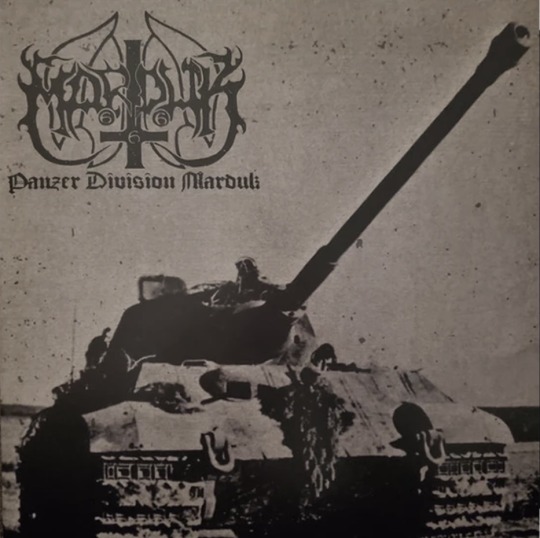
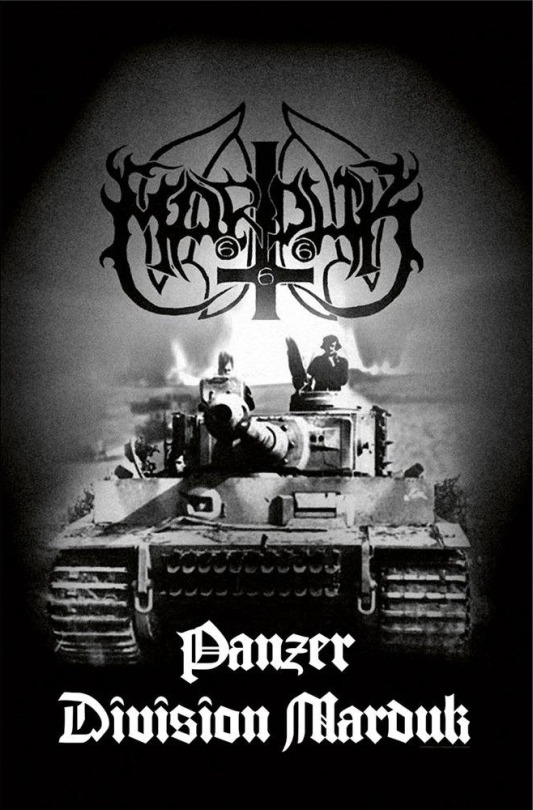

MARDUK “Panzer Division Marduk”, LP 1999 (Fire ! Attack, attack, attack !! Waaaaaarrrrrrr !!! All I want, all I need is to see my enemies bleed)
“Warcries pierces the autumn mist Gunfire penetrate frontlines Panzers storming as an iron fist Gunfire penetrate frontlines Steel and fire collide with a crash Panzers plunge into the front Crushing the bodies of the foes with a splash Panzers plunge into the front Scorched earth The soil soaked with blood On the ground nothing more can burn Scorched earth The absence of god A mistake the enemy will learn Blowtorch battalion burning the flank As fanatics the foes they attack The thousand soldiers with battletanks As fanatics the foes they attack Through the Losheim pass striving on to the West They seal their fate and their souls Leaving their prisoners in eternal rest They seal their fate and their souls Attacking - The holy cause must be fulfilled No mercy - Take pride in the thrill of the kill Omens - The horoscope of time shows war Victory - Forevermore Indefatigable battalions of storm Destined to kill and be killed Spearheads which rolling relentless they form Destined to kill and be killed The griffin protects us with beak and with claws No enemy can bring forth our death We must win to save us forth our death We must win to save us from the plagues grasping jaws No enemy can bring forth our death Scorched earth The soil soaked with blood On the ground we draw our last breath Scorched earth We meet our god But our banner is greater than death Scorched earth - Two hundred thousand men have died Scorched earth - Tunnel of light in high tide Scorched earth - Nothing new in history Scorched earth - Massive death for our glory”
#Marduk#Black Metal#Panzer Division#Morgan 'Evil' Håkansson#B. War#Fredrik Andersson#Legion#Blooddawn#Osmose Productions
17 notes
·
View notes
Text

• Hermann Hoth
Hermann Hoth was a German army commander and war criminal during World War II. He fought in the Battle of France and as a panzer commander on the Eastern Front.
Born in Neuruppin, German Empire on April 12th, 1885, Hoth joined the army in 1903 and was awarded both classes of the Iron Cross during World War I. He remained in the Reichswehr (the armed forces of the Weimar Republic) in the interwar period. Following the reorganization of the German military into the Wehrmacht in 1935, he was appointed to command the 18th Infantry Division. Hoth was promoted to Lieutenant-General and given command of the XV Motorised Corps in 1938, leading it in the invasion of Poland the following year. During the invasion of France in May 1940, his panzer corps was on Guderian's right flank during their advance through the Ardennes, and contained the 5th Panzer and 7th Panzer Divisions. Hoth was promoted to Generaloberst in July 1940.
In Operation Barbarossa in 1941, Hoth commanded the 3rd Panzer Group which captured Minsk and Vitebsk as part of Army Group Center's operations. In mid July, the 3rd Panzer Group was subordinated to Army Group North to shore up the flanks and attempted to seize Velikie Luki. Hoth's forces were driven back on July 20th, when Red Army forces broke through the German lines, prompting criticism from Field Marshal von Bock, commander of Army Group Center for unnecessarily striking out too far to the north east. In mid to late August, Hoth's forces faced another setback owing to heavy losses and dispersal of efforts: facing the heavily reinforced Soviet 19th Army, he committed the 7th Panzer Division without infantry support, which resulted in what historians described as "debacle". The division's attack ran into fortified Soviet lines and was repulsed with the loss of 30 tanks. As with all German armies on the Eastern Front, Hoth's Panzer Group implemented the Commissar Order. According to reports from subordinate units, the order was carried out on a widespread basis. In October Hoth was appointed commander of the 17th Army in Ukraine. Hoth was an active supporter of the war of annihilation (Vernichtungskrieg) against the Soviet Union, calling on his men to understand the need for "harsh punishment of Jewry". Under Hoth's command, units of the 17th Army took part in the hunt for and murder of Jews in its territory of control. Following the issuance of the Severity Order by Walter von Reichenau in October 1941; he issued the following directive to troops under his command in November 1941. "Every sign of active or passive resistance or any sort of machinations on the part of Jewish-Bolshevik agitators are to be immediately and pitilessly exterminated".
During the Soviet winter offensives of early 1942, Hoth's 17th Army was driven back in the Second Battle of Kharkov. In June 1942, he took over from General Richard Ruoff as commander of 4th Panzer Army. As part of Operation Blue, the German offensive in southern Russia, the army reached the Don River at Voronezh. Hoth was then ordered to drive to Rostov-on-Don. It then advanced to the north in support of the Sixth Army's attempt to capture Stalingrad. In November 1942, the Soviet Operation Uranus broke through the Axis lines and trapped the Sixth Army in Stalingrad. Hoth's panzer army led the unsuccessful attempt to relieve the Sixth Army (Operation Winter Storm), under the overall command of Field Marshal Erich von Manstein's Army Group Don. By December 25th, the operation had failed.
In February 1943, Hoth's 4th Panzer Army participated in the counteroffensive against the Soviet forces advancing in the Donbass region. The operation was hastily prepared and did not receive a name. Later known as Third Battle of Kharkov, it commenced on February 21st, as the 4th Panzer Army launched a counter-attack. The German forces cut off the Soviet mobile spearheads and continued the drive north, retaking Kharkov on March 15th, and Belgorod on March 18th. Exhaustion of both the Wehrmacht and the Red Army coupled with the loss of mobility due to the onset of the spring rasputitsa resulted in the cessation of operations for both sides by mid-March. The counteroffensive left a salient extending into the German area of control, centered around the city of Kursk, and leading up to Operation Citadel. In July 1943, Hoth commanded the 4th Panzer Army in the Battle of Kursk as part of Army Group South. Operation Citadel called for a double envelopment, directed at Kursk, to surround the Soviet defenders and seal off the salient. The Army Group South committed Hoth's 4th Panzer Army, alongside Army Detachment Kempf. Hoth's divisions, reinforced by the II SS Panzer Corps under Paul Hausser, penetrated several Soviet defensive lines, before being brought to a halt in the Battle of Prokhorovka. In the aftermath of Kursk, the Red Army mounted a series of successful offensives that crossed the Dnieper, retook Kiev and pushed the Germans out of eastern Ukraine. In September 1943, Hoth's army was operationally penetrated by Red Army units and was unable to maintain a continuous front line even in retreat. The army crossed the Dnieper south and north of Kiev with heavy losses. On December 10th, 1943, Hoth was relieved of command, and was not recalled until April 1945.
Following the end of the war, Hoth was tried at the Subsequent Nuremberg Trials, in the High Command Trial. During his testimony he sought to explain his November 1941 order aimed at elimination of the "Bolshevik-Jewish resistance". He claimed that his instructions only meant that his troops should be vigilant and were intended to improve morale: "The German soldier in his good nature ... easily forgot that he was still in enemy territory" and that the "power of Bolshevism had to be broken". He insisted that no physical harm came to civilians as the result of this measure, which his troops executed with "clean hands". Hoth maintained that if any Jews had been killed it was due to their connection to crimes against the German forces. "It was a matter of common knowledge in Russia that it was the Jew in particular who participated in a very large extent in sabotage, espionage, etc.," Hoth claimed. Hoth was found guilty of war crimes and crimes against humanity. On October 27th, 1948 he was sentenced to 15 years in prison. In January 1951, the sentence was reviewed with no changes. Hoth was released on parole in 1954; his sentence was reduced to time served in 1957. Hermann Hoth died on January 25th, 1971 in Goslar, West Germany, he was 85.
#second world war#world war 2#world war ii#wwii#military history#history#german history#biography#operation barbarossa#eastern front#stalingrad#panzer division#long post
60 notes
·
View notes
Text
Battle of the Bulge (1965)

Basic Story: The German counterattack in the Ardennes forest in the winter of 1944.
Fan Thoughts: In their attempt to cover the entire Ardennes Counteroffensive, the writers rearranged the events and came up with fictional characters rather than depicting actual Allied leaders. I tend to refer to this movie as a historical movie that contains almost no actual history, on top of the rearrangement of events, there are huge pieces of the offensive that are left out entirely, the tanks used for both the Germans and Americans are the incorrect types, the list goes on. The film starts with Lieutenant Colonel Daniel Kiley (Henry Fonda) spotting a German staff car containing Colonel Martin Hessler (Robert Shaw) on a reconnaissance mission and ‘buzzing’ him to get a better picture. After this encounter, Hessler reaches the Nazi bunker where he is briefed on the new German attack, the same one that Kiley was looking for evidence of on his reconnaissance mission, and the plan to use of German soldiers posing as Americans to hold bridges and create confusion. Kiley’s observations are brushed off, so he visits a spot on the Siegfried Line commanded by Major Wolenski (Charles Bronson), where a patrol catches some young German soldiers, Kiley concludes that the experienced soldiers have been pulled back for a new offensive, but his hunch is again written off. The German offensive is launched, and Wolenski is overrun after leading his men to the woods near Schnee Eifel. Sergeant Guffy (Telly Savalas) leads a group of tanks against the Panzers but is forced to retreat. Simultaneously, the Germans saboteurs take the Our Bridge, Kiley notices that a German truck was carrying empty fuel drums, and Guffy splits the proceeds from his black markets dealings with his business partner Louise. The sabotage by the Germans continues when they turn roadsigns so some of Wolenski’s troops go the wrong way; they are captured and instead of being taken as POWs, they are massacred, but Lieutenant Weaver (James MacArthur) manages to escape. The saboteurs at the Our Bridge are discovered when the Americans realize the charges are set incorrectly, but this realization comes too late to stop the Panzers from crossing. The Germans continue on to take Ambleve and capture many retreating Americans, those who escape regroup at the River Meuse. Kiley goes out on another renaissance mission in the fog to find the German spearhead, ordering the pilot to glide to try and hear the tanks, he spots them but is then hit by the Germans and crashes.American forces face Hessler’s tanks, while Guffy meets with Weaver and they head to the fuel depot, however the German saboteurs also head to the depot to capture it. As shown by this extremely long summary, this is a very long film that would have benefitted from having several scenes trimmed or removed entirely. Additionally, the scenes vary wildly in brightness and color; the outdoor shots are often at ‘night’ so they were filmed during the day and a filter was placed over them, which removes contrast and makes the action difficult to see. These dark scenes are juxtaposed by almost overly bright indoor shots that have the classic 60s film look of large sets with bright colors. For instance the Nazi bunker scenes all look like they belong in James Bond film from the same era. While this may be considered a classic, in fact I actually watched this on the “Turner Classic Movies Greatest Classic Films Collection” DVD, the historical inaccuracies and long runtime keep this film from being an engaging watch.
Warnings: wartime violence (mostly bloodless), one civilian is executed
Available On: Amazon Prime, Vudu, iTunes, YouTube, Google Play, Sling TV
11 notes
·
View notes
Photo

1944 09 22 Cutting Hell's Highway Panzer-Brigade 107 - Steve Noon
Cutting Hell's Highway, Black Friday, September 22, 1944 After the Allies capture of the Nijmegen Bridge, Model was convinced that their hold on the narrow corridor and road from Eindhoven to Nijmegen was tenuous and left the Allies vulnerable to entrapment. At 0900 hours on September 22, Panzer-Brigade 107 launched it's attack to cut the route. Panzer- Abteilung 2107 moved towards the road between Uden and Veghl at around 1100 hours. We see here the moment the Panther tanks encountered a column of British trucks from 123rd LAA Regt., towing anti-aircraft guns towards Nijmegen. Several Bedford trucks were destroyed and having overwhelmed the British column, the Panther tanks followed the road Southwards towards Veghel, where they were to spearhead the battle for the town.
14 notes
·
View notes
Photo
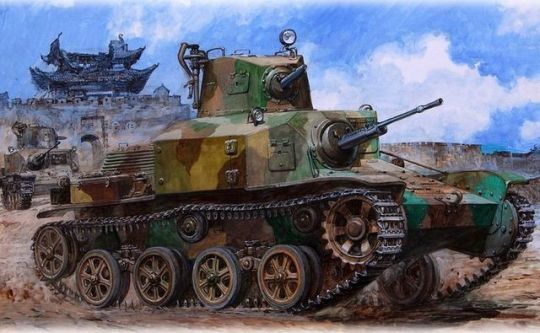

Tanks of the Rising Sun
Introduction; Japanese Tank Doctrine from 1930′s to 1945
When I was planning out this series at first I was unsure where I should place this segment, whether I should just put it somewhere around the middle of the series as I go or have it at the end as an addendum. After some thought I decided that detailing how the Japanese used their tanks would probably be the best place to start, then get into the fine details of Japanese tanks and tank doctrine, most likely mentioning and restating many of the points I've made in this post again to better detail how changing doctrine resulted in changing tank designs. So, here goes...
Japan is unique in that in the 1930's and World War II it was the only non-western nation to build it's own tank force, and while among military history buffs American, Soviet, German, and British tanks are famous, Japanese tanks are a relatively unknown afterthought. Japan's first experience with tank warfare occurred during World War I when the British donated two Whippet Tanks to the Imperial Japanese Army (IJA) in 1918, which were deployed in Japan's intervention during the Russian Civil War. In the early 1920's Japan purchased several French Renault FTs, which spurred more Japanese interest in tank warfare and design. Japan's tank program began in 1925 when it attempted to design and build it's first indigenous tank, which was a failure. The first successful tank, the Type 89 I-Go medium tank was adopted in 1928, and the first deployment of tanks in combat occurred in 1932 with the First Battle of Shanghai.
Type 89 I-Go during the Battle of Shanghai, 1932

In those early days of tank warfare, there was much debate as to how tanks were supposed to be used with almost all major powers agreeing that tanks were primarily to be used for infantry support. Japan was no exception, with Japanese tank doctrine up until World War II primarily focused on using medium tanks to support infantry assaults on enemy positions. These tanks sported guns that were of relatively high caliber and low velocity and were primarily used to lob high explosive shells in order to destroy enemy fortifications such as pillboxes, machine gun nests, rifle pits, and trenches. While these guns and shells were effective against soft targets, they were often ineffective against other tanks or armored vehicles. Medium tanks were also very slow so that infantry could keep pace with them. Faster light tanks, armored cars, and tankettes were to be used similar to the cavalry by acting as reconnaissance vehicles, escorts, and skirmishers. While this was official doctrine, it was not uncommon for light tanks and armored cars to be pressed into the same combat role as medium tanks. Since most Japanese military operations in the 1930's occurred in China the Japanese could get away with this. The Chinese lacked anti-tank weaponry and only had a token tank force of their own, leaving Japanese armored forces practically uncontested during the 1930′s.
Japanese tank doctrine and development radically changed between 1939 and 1941 as a result of two events. First was the Japanese invasion of Mongolia, a disastrous campaign leading to the Battle of Khalkin Gol where Soviet armored forces and anti-tank guns revealed Japanese tanks to be woefully behind in technology. Second and most important was Germany's infamous blitzkrieg across Europe spearheaded by their Panzer divisions. Whereas before doctrine held that tanks were for infantry support, the Germans demonstrated that tanks were a powerful offensive weapon in their own right. The Japanese attempted to shift their tank doctrine from the old style of tanks supporting infantry, to the new German style of armored warfare with infantry supporting tanks. This, however, proved impossible and was too little, too late for several reasons. First the war shifted to other parts of the Pacific which were mostly either dense jungle, mountains, or small islands with terrain not conducive to maneuver warfare. Second, Japanese priorities moved away from tanks as naval forces became more important. Japan had limited amounts of steel and most was used to support the Imperial Japanese Navy in order to maintain what was now a massive maritime empire. This not only included warships and naval aircraft, but the hundreds if not thousands of supply ships needed to support both the navy and the army.
Japanese Empire in 1942, the conquest of a large island empire forced Japan to redirect resources away from tank production and design in order to maintain a large navy.

As a result Japanese tank production suffered, peaking in 1941 and sharply decreasing thereafter.
The only country where Japan could conduct mobile tank warfare was in China, however this was foiled by American involvement in World War II when the United States started supplying the Chinese Army with anti-tank weapons and Sherman tanks. The new Sherman tank could easily curbstomp most Japanese tanks, whose piddly little guns fired shells that merely bounced off the Sherman's thicker armor and whose paper thin armor was helpless against the Sherman’s 75mm gun. Even infantry anti tank weapons such as the bazooka could easily make short work of Japanese tanks. Tanks that were state of the art in the 1930′s and did well on Chinese battlefields were now obsolete compared to those of the Western Allies. Thus in China the Japanese went from being the unquestioned master of armored warfare to being completely dominated by Chinese and Allied forces. Japanese Blitzkrieg in China was not gonna happen.
Chinese Sherman Tank in Burma

In the rest of the Pacific Theater, as a result of terrain Japanese tanks were mostly used as infantry support or static defense. In island warfare they were usually entrenched in fortified positions, with the chassis buried and only the turret sticking out.
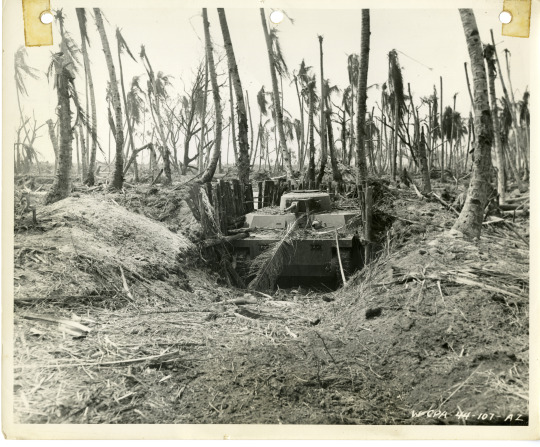
The Japanese had some dedicated anti-tank guns, but usually not enough, resulting in such entrenched tanks being expected to act in an anti-tank role. This was a very flawed idea, not only because tanks that are immobile make poor tanks, but as I mentioned in the previous paragraph Japanese tanks could not compete with the American Sherman as well as other Allied tanks such as the British Matilda. Such fortified, stationary tanks also made easy pickings for infantry who could knock it out with anti-tank weapons or rush it’s position and destroy it with bombs.
The final phase of Japanese tank warfare during this era I would call the "desperation phase". This occurred during the final years of the war when it was clear that Japan would lose and Japanese forces resorted to tactics such as suicide bombs and kamikaze strikes. On a few occasions Japanese tank forces conducted what were essentially armored "banzai charges", which were massive, suicidal frontal assaults against Allied forces with disastrous results. On the night of June 16th, 1944, during the US invasion of Saipan 44 Japanese tanks conducted one such charge against American Marines, who were supported by a platoon of M4A2 Sherman tanks and 75mm anti tank half tracks. After a short battle, all but a few of the tanks were knocked out and destroyed with minimal American losses. In other battles smaller but similar tank assaults occurred with similar results. In 1945 a company of Japanese tanks attempted a similar attack against a force of 100 Soviet T-34 tanks during the Soviet invasion of Manchuria. Rather than obey orders from the Imperial Government to surrender, the company chose to go out in a blaze of glory, and the Soviets obliged without suffering any casualties.
In the next installment I’m going to get into individual tanks models and the history of Japanese tank development.
To Be Continued...

549 notes
·
View notes
Photo

Breaking out Stalingrad ‘42. My friends place has a big window in the room where we game, so we get a lot of light during the day which makes some interesting pictures. I took the Soviets this time because I wasn’t quite feeling up to running the big offensives - but wow, playing defense with the Soviets is hard! The German spearheads are just so fast, it’s really hard to avoid getting lots of guys pocketed. You actually have a decent armored reserve of pretty good tank corps, but it’s just hard to compete with the agility of the large number of German mechanized formations. I’ve been playing a fair amount of Holland ‘44 recently; that game is just so constructed, while this is a panzer-pusher’s delight of wide open spaces. Anyway, it’s cool, and like all Simonitch games, it just plus like a dream for a game of this scope and scale. The 8 turn Case Blue scenario is not crazy playing time wise and is action packed. Outside of conventions I usually have to break most of these up into two sessions, but they fit quite comfortably into two afternoon or evening games. Looking forward to getting better at this one 😆 #bgg #boardgamegeek #tabletopgames #gmtgames #marksimonitch #stalingrad42 https://www.instagram.com/p/B5Mu0cKh8D6/?igshid=114zpo99glp8e
12 notes
·
View notes
Photo

1940 The road to Dunkirk - Nicolas Trudgian
The 19th of May 1940 was a day of hectic aerial fighting as the greatly outnumbered fighters of the R.A.F. battled to keep the Luftwaffe away from the retreating British Army. By the close of the day, courageous Hurricane pilots had claimed close to 100 enemy aircraft. In ‘THE ROAD TO DUNKIRK’, Nicolas Trudgian’s brilliantly evocative portrayal of war-torn French countryside in early summer 1940, Flying Officer Max Aitken, flying his Hurricane of 601 Squadron, attacks Ju87 Stukas of StG2 as they attempt to strafe and bomb a British Army column retreating from the Panzer spearheads near Arras.
85 notes
·
View notes